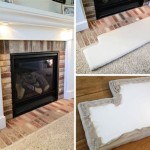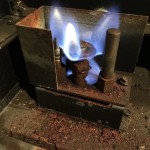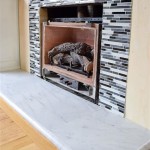Gel Flame Fireplaces: A Comprehensive Overview
Gel flame fireplaces offer a distinct alternative to traditional wood-burning or gas-powered fireplaces. They utilize a fuel source consisting of gelled alcohol, typically contained within cans, to produce a visible flame. These fireplaces are gaining popularity due to their ease of installation, portability, and relatively clean-burning characteristics. This article will provide a comprehensive examination of gel flame fireplaces, including their mechanics, advantages, disadvantages, and safety considerations.
The fundamental principle behind a gel flame fireplace revolves around the combustion of denatured alcohol in a gelled form. The gel is made by adding a thickening agent to alcohol, creating a viscous substance that allows for controlled burning. When ignited, the gel vapors combust, producing a flame that mimics the appearance of a wood fire, although without the characteristic crackling sound. The fuel cans are typically placed within a decorative housing, designed to contain the flames and enhance the aesthetic appeal of the fireplace.
Mechanism and Operation
Gel flame fireplaces function by directly burning denatured alcohol in a gelled state. The gel itself acts as a carrier for the alcohol, preventing it from rapidly evaporating. Once a flame source is applied to the gel, the alcohol vapors are ignited, creating a clean-burning flame. The flame intensity depends on the composition of the gel fuel and the size of the opening in the can. Larger openings allow for more fuel to vaporize, resulting in a larger flame. A typical gel fuel can will burn for approximately 2 to 3 hours, depending on the size and the fireplace design. The burning process produces primarily carbon dioxide and water vapor, making it a relatively clean combustion process compared to traditional wood-burning fireplaces.
The fireplace itself primarily serves as a container and decorative element. It is crucial to ensure adequate ventilation around the fireplace to prevent the buildup of carbon dioxide. Some models incorporate features like adjustable flame heights or dampers to control the rate of fuel consumption. While simple in design, these fireplaces offer a convenient and aesthetically pleasing way to introduce a flame element into a room without the need for chimneys or gas lines.
Advantages of Gel Flame Fireplaces
Gel flame fireplaces offer several advantages that contribute to their growing popularity. One significant advantage is the ease of installation. These fireplaces do not require complex venting systems, chimneys, or gas lines. This allows them to be placed virtually anywhere in a home or apartment, providing greater design flexibility. Many models are freestanding and portable, further enhancing their versatility. This ease of installation makes them particularly appealing to renters or individuals looking for a temporary heating solution.
Another advantage lies in the relatively clean-burning nature of the fuel. Gel fuel produces significantly less soot and particulate matter compared to wood-burning fireplaces. This reduces the risk of indoor air pollution and eliminates the need for chimney cleaning. This clean burning also contributes to a healthier indoor environment. Although the combustion produces carbon dioxide, it is typically at levels comparable to those produced by burning candles. Proper ventilation is still recommended to maintain good air quality.
Furthermore, gel flame fireplaces are generally less expensive than traditional fireplaces. The initial investment is lower, and ongoing maintenance costs are minimal. The fuel cans are readily available at most home improvement stores and are relatively inexpensive. This makes them an attractive option for budget-conscious consumers who still desire the ambiance of a fireplace.
Disadvantages and Safety Considerations
Despite their advantages, gel flame fireplaces also have limitations. One significant disadvantage is the lack of significant heat output. While they produce a visible flame, the heat generated is often insufficient to effectively heat a large room. They are primarily used for ambiance and aesthetic appeal rather than as a primary heating source. The heat generated is typically localized and dissipates quickly.
Safety is paramount when using gel flame fireplaces. The primary concern is the risk of fire. It is crucial to ensure that combustible materials are kept away from the fireplace. Always follow the manufacturer's instructions carefully regarding fuel loading and operation. Refilling the fuel cans while the fireplace is still hot is extremely dangerous and should never be attempted. Allow the fireplace to cool completely before adding more fuel.
Adequate ventilation is also crucial for safe operation. Although the combustion is relatively clean, it still produces carbon dioxide. Insufficient ventilation can lead to a buildup of carbon dioxide, potentially causing health problems. It is recommended to operate the fireplace in a well-ventilated room and to monitor for any signs of carbon monoxide buildup, although carbon monoxide production is generally low. Furthermore, the open flame poses a burn hazard. Children and pets should be kept away from the fireplace to prevent accidental contact with the flame or hot surfaces.
The fumes from the gel fuel can also be a consideration for individuals with sensitivities. While generally considered low-odor, some individuals may experience irritation from the fumes. Testing the fireplace in a well-ventilated area before regular use is recommended to identify any potential sensitivities.
Fuel Considerations and Best Practices
The type of gel fuel used is crucial for optimal performance and safety. Use only fuels specifically designed for gel flame fireplaces. Using alternative fuels can be dangerous and may produce harmful emissions. Read the fuel packaging carefully for instructions and warnings. Store fuel cans in a cool, dry place away from heat and open flames. Never modify or tamper with the fuel cans, as this could lead to dangerous combustion.
When lighting the fireplace, use a long-handled lighter or matches to avoid accidental burns. Ensure the fuel cans are properly seated within the fireplace before ignition. Never leave the fireplace unattended while it is burning. Always extinguish the flame completely before leaving the room or going to sleep. Use the extinguishing tool provided with the fireplace or a metal object to smother the flame. Never use water to extinguish a gel flame, as this could cause the alcohol to spread and potentially ignite other materials.

Terraflame 25 5 In X Gel Fuel Fireplace The Ethanol Fireplaces Department At Com

Lloyd Modern Gel Fuel Fireplace Luxury Fire

Gel Burning Fireplaces Shipped Factory Direct Just

Gel Fuel Fireplace How Does It Work Hearthcabinet

The Fireplace Element Inspiration Gel Fuel

Ashley Vent Free Gel Fueled Fireplace Black Plow Hearth

Indoor Outdoor Mid Mod Gel Fuel Fireplace Sky Blue Vivaterra

Real Flame Gel Fuel 12 Pack

Fireplaces Gel Fuel Real Flame Silverton Fireplace In White G8600 W

Gel Fireplace Logs Can Transform An Unused Future Expat
Related Posts








